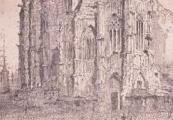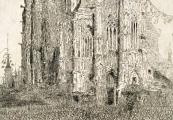This archived website ‘James Ensor. An online museum.’ is temporarily not being updated. Certain functionality (e.g. specific searches in the collection) may no longer be available. News updates about James Ensor will appear on vlaamsekunstcollectie.be. Questions about this website? Please contact us at info@vlaamsekunstcollectie.be.
Editions and States
Apart from a few exceptions James Ensor did not number his prints. The etchings and engravings were printed at different times and in several circulation numbers. Prior to 1900 sales did not go very well and according to Loÿs Delteil, author of the second annotated catalogue of the prints, the works were printed in small numbers. During the 1920's the circulation numbers multiplied. The difference between the early and the late printings is clearly visible. The differences can be seen in the type and size of the paper, and in the inscriptions. The old engravings were printed on small sheets of Chinese or Japanese paper, Dutch papier vergé or on vellum. They were signed with a little, sloping signature. The more recent etchings were executed on Japanese simili paper of medium or large format, and show a straight signature. The title of the work was applied on the reverse with, diagonally, a wide arabesque into which the name of the artist has been incorporated. Care should be taken when it comes to these generalizations though, since Ensor sometimes signed old prints which he had kept himself later on.
A lot of plates have several editions. In many cases it is only a matter of small changes and additions. Nearly all of the plates were preserved but, after the artist's death, the heirs rendered them useless by applying little scratches in the corners. Due to rapid wear Ensor revised the plates of some of the dry-point engravings later on completely with spirits. In a number of cases he reproduced the same subject a few years later on a new plate. James Ensor had a habit of touching up some of his prints afterwards with water colour, gouache or coloured chalk. He even made little paintings out of a few of them. The artist embellished his prints especially at an older age; he probably did this to make less good printings more saleable or to mask the inferior quality of certain prints.









